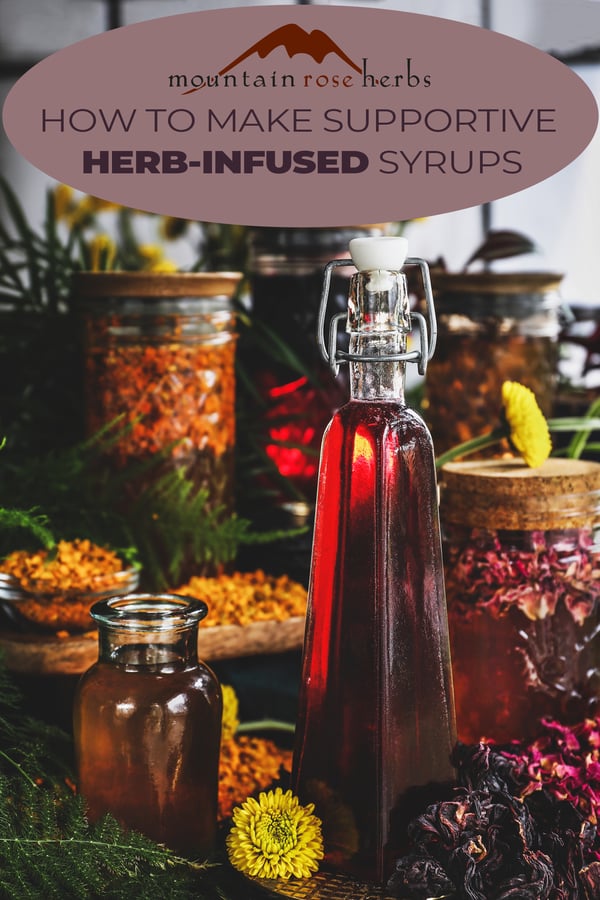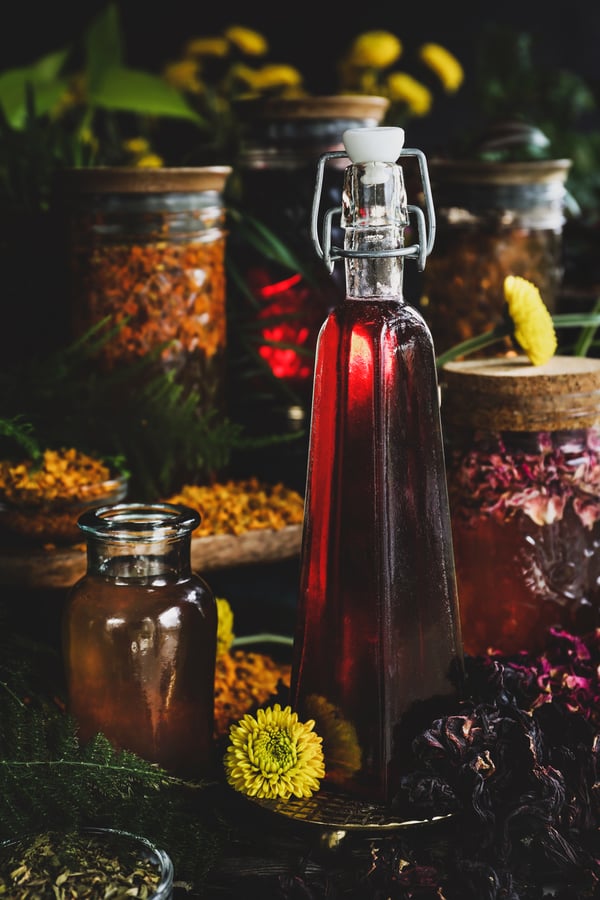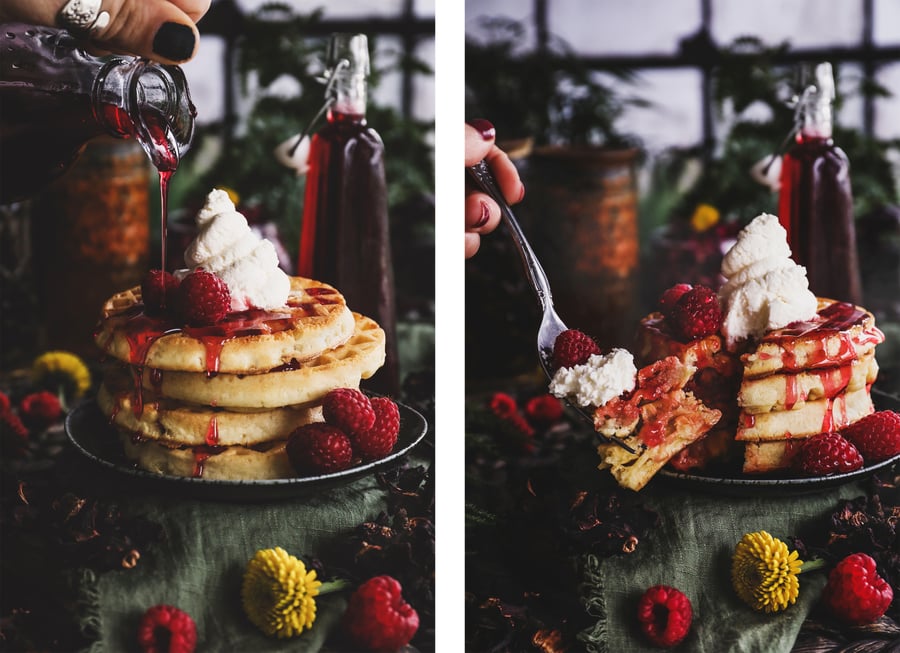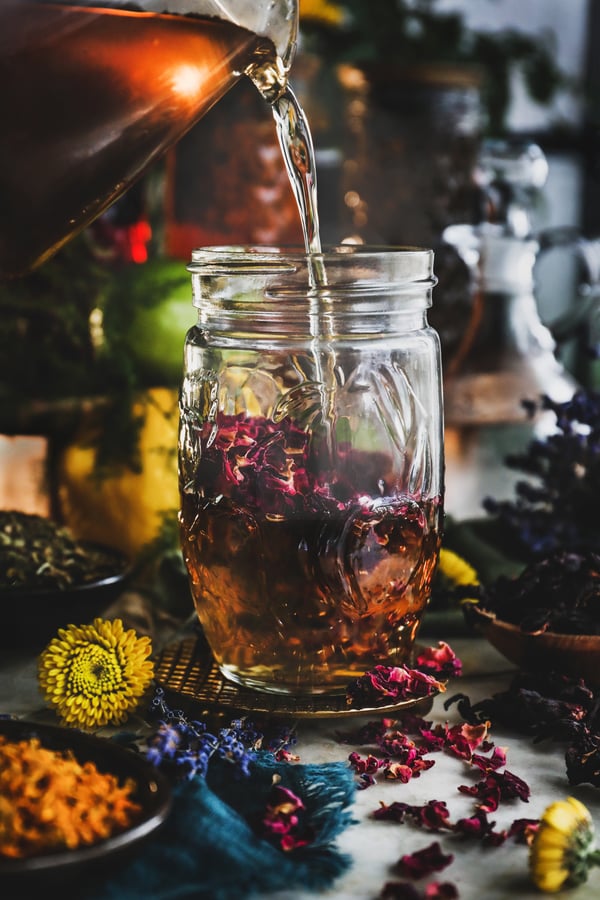Simple syrups are a fun and surprisingly useful ingredient to keep on hand in your refrigerator, especially when they are infused with your favorite herbs. A lot of people think of mocktails or cocktails when they think of simple syrups, and that’s definitely a good use for them. But they are equally wonderful added to carbonated water, as sweetener in tea, brushed on cakes or cupcakes, drizzled on yogurt or pancakes, and more. They are called “simple” syrup for a reason—if you can boil water, you can make simple syrup. And infusing simple syrups with herbs takes them from being a good ingredient to an amazing one!
A lot of people are familiar with adding fresh herbs to their simple syrups, but I prefer dried herbs for two reasons. Unlike fresh botanicals, dried herbs give me consistent results. Also, dried herbs are convenient and readily available—I have them on hand all year, so I’m not constrained by what is in season. Popular favorites for simple syrups include cinnamon, lavender, basil, mint, orange, vanilla, rose, and hibiscus. I’m also a big fan of turmeric root, ginger root, elderflowers, and roasted cacao nibs. Another fun option is to use herbal tea blends!
It’s up to you what sugar you use in making simple syrups. I generally use organic sugar or demerara sugar, which makes a golden colored syrup. It’s more traditional to use white sugar, because it creates a crystal-clear syrup with clean flavor, but I don’t like to use sugar that has been bleached. You can also use brown sugar, honey, agave syrup, etc. Just note that you may need more or less of these sweeteners to achieve the same results.
Simple Syrup Ratio
The ratio of water to sugar will obviously affect the flavor but also the texture of whatever you use it in. The consistency of a simple syrup is key.
1:1 (Equal parts sugar and water)—One part sugar to one part water is the standard, medium-consistency simple syrup. This is my go-to because I prefer it in bubbly water and it also works well for brushing on cakes, plus it’s good in a lot of cocktails and mocktails.
1:2 (1 part sugar to 2 parts water)—This lower-sugar syrup is thinner in consistency and less sweet than the standard equal-parts version. I think it is a good ratio for cocktails and mocktails, especially if they also include juice because it incorporates easily without changing the mouthfeel and it lets the other flavors shine.
2:1 (2 parts sugar to 1 part water)—The higher ratio of sugar in this simple syrup makes a thicker syrup that is not ideal for drinks, but can be very good for some baking projects, making candies, and spinning sugar.
How Long Does Simple Syrup Last?
The shelf life of your homemade simple syrup depends on the sugar ratio and how you dissolve the sugar. Sugar is a preserving agent, so the higher the sugar ratio, the longer the shelf life. Therefore, a thicker 2:1 syrup will have a longer shelf life than a thinner 1:2 syrup.
Shelf life also depends on whether or not you heat the syrup. You can make simple syrup without cooking it by shaking or stirring the sugar with room temperature water until the sugar dissolves. This is technically how hummingbird food is made. But this syrup will need to be used fairly quickly. Even when refrigerated, it may only have a shelf life of up to a week. A better method is to heat the sugar and water because it helps to completely dissolve the sugar crystals and extends the shelf life. Many people heat the sugar and water over low heat without boiling just until the sugar dissolves. Personally, because I use organic sugar or demerara, I bring it to a boil. This ensures that those larger sugar crystals are fully dissolved, which significantly extends the shelf life.
A 1:1 simple syrup that has been heated to dissolve all the sugar crystals, and then stored in a clean, sterile glass container in the refrigerator will last at least one month.
Want to extend the life of your simple syrup even longer? Freeze it! Pour into ice cube trays or a silicone mold to freeze. Then pop the cubes out of the tray and put into a freezer container. Be sure to label with date made and flavor of syrup. Now you have cubes to use whenever you want! Note that if you make a thicker syrup, it may not freeze as hard, and you may want to separate the cubes so they don’t stick together.
1:1 Simple Syrup Recipe with Dried Herbs
Makes just over 1 cup of simple syrup.
Ingredients
- 1 cup organic sugar or demerara sugar
- 1 cup water
- 2-4 Tbsp. dried herb(s) of choice
Directions
- Combine sugar and water in a saucepan over medium heat.
- Bring to a boil, stirring regularly, to fully dissolve sugar.
- Meanwhile, put herb(s) in a clean, sterile jar.
- When sugar has fully dissolved and syrup has come to a boil, remove from heat and pour syrup over herbs in the jar. Let the jar rest for a couple of minutes to cool slightly.
- Seal with a tight fitting lid. Wrap a dish towel around the jar and shake to combine.
- Set aside to cool for at least half an hour, or until room temperature, shaking the jar occasionally.
- Strain out herbs through a double layer of cheesecloth.
- Pour syrup into a clean, sterile jar with an airtight lid. Label and store in the refrigerator. Alternatively, pour simply syrup into an ice cube tray or silicone mold and freeze. Store cubes in a freezer-safe container.
Pro Tips
- Particularly aromatic herbs like dried mint, lavender, or ginger root usually require just 2 Tbsp. to beautifully flavor 1 cup of simple syrup, whereas turmeric root, hibiscus, or basil may need double that amount.
- It’s important to store simple syrup in the refrigerator or freezer, because at room temperature, a homemade simple syrup can start to crystalize within hours.
- If you are using raw honey to make simple syrup and want to maintain the pollen, propolis, antioxidants, and enzymes, be sure not to heat it above 110°F. Honey simple syrup will have a shorter shelf life than syrups made with sugar.
- If a syrup becomes murky, cloudy, or forms mold on the surface, it should be discarded.
Want Another Delicious Syrup Recipe?
Try This Bilberry and Hawthorn Berry Syrup!
You may also be interested in:
- How to Make Elderberry Syrup for Immune Support
- Fruit and Herb-Infused Water Recipes
- Instant Herbal Tea Cubes














